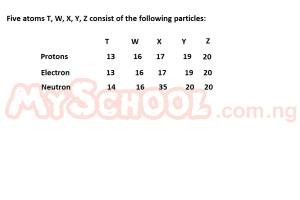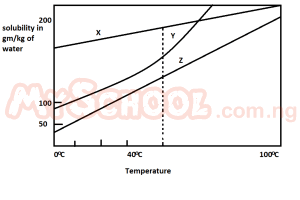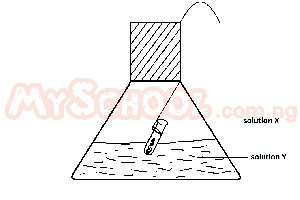Year :
1978
Title :
Chemistry
Exam :
JAMB Exam
Paper 1 | Objectives
41 - 48 of 48 Questions
| # | Question | Ans |
|---|---|---|
| 41. |
You are provided with five gas jars containing SO2, CO2, H2, CO and NO respectively. Select a test from A to E which will identify ANY ONE of the gases completely A. pass each gas into lime water B. pass each gas into water and test with litmus paper C. pass each gas into concentrated sulphuric acid D. expose each gas to atmospheric air E. expose each gas to fumes of hydrogen chloride |
A |
| 42. |
Which of the following substances would you see as an indicator in the titration of sodium carbonate solution against hydrochloric acid (complete neutralisation)? A. Litmus paper B. Phenolphthalein C. Methyl orange D. Universal indicator E. None of these |
C |
| 43. |
 Which of the five atoms can be described by the following properties: Relative atomic mass is greater than 30 but less than 40, it has odd atomic number and forms a unipositive ion in solution? A. T B. W C. X D. Y E. Z Detailed SolutionY = 19 protons, 19 electrons and 20 neutrons.Y has electronic configuration 2, 8, 8, 1. Hence, it has one valence electron in the outer shell (Valency of +1). Mass number = protons + neutrons = 19 + 20 = 39. |
|
| 44. |
A solid X when heated gives off a brown gas. If X is soluble in excess sodium hydroxide solution but insoluble in excess ammonium hydroxide solution, then X is A. basic lead carbonate B. lead (II) nitrate C. sodium carbonate D. zinc nitrate E. sodium nitrate |
B |
| 45. |
 Consider the solubility curves of three salts X, Y and Z given in the diagram. If each solution of the salt contains 200 g, and is heated to 100oC, which solution or solutions will deposit 100 g of the solute when suddenly cooled to 0oC? A. X only B. Y only C. Z only D. X and Z E. Y and Z |
E |
| 46. |
 An experiment test of the Law of conservation of Mass is illustrated in the diagram. In practice, the flask is weighed before and after reaction between solutions X and Y. Which of the following pairs of solutions will be unsuitable for the experiments A. X = hydrochloric acid; Y = silver nitrate B. X = barium chloride; Y = dilute sulphuric acid C. X = hydrochloric acid; Y = sodium hydroxide D. X = hydrochloric acid; Y = lead nitrate E. X = hydrochloric acid; Y = sodium carbonate |
E |
| 47. |
Five compounds R,T,W,X and Y form the following compounds: a basic hydride R.H, an acidic hydride YH, atmospheric oxide W2O3, XO2. which of the elements is an alkali A. R B. T C. W D. X E. Y |
A |
| 48. |
The size (diameter) of five elements are in the order R < T < W < X < Y, Y being the largest. If each atom has an electron situated on its circumference, and neglecting other factors, which of the atoms will lose its electron most reluctantly? A. R B. T C. W D. X E. Y |
A |
| 41. |
You are provided with five gas jars containing SO2, CO2, H2, CO and NO respectively. Select a test from A to E which will identify ANY ONE of the gases completely A. pass each gas into lime water B. pass each gas into water and test with litmus paper C. pass each gas into concentrated sulphuric acid D. expose each gas to atmospheric air E. expose each gas to fumes of hydrogen chloride |
A |
| 42. |
Which of the following substances would you see as an indicator in the titration of sodium carbonate solution against hydrochloric acid (complete neutralisation)? A. Litmus paper B. Phenolphthalein C. Methyl orange D. Universal indicator E. None of these |
C |
| 43. |
 Which of the five atoms can be described by the following properties: Relative atomic mass is greater than 30 but less than 40, it has odd atomic number and forms a unipositive ion in solution? A. T B. W C. X D. Y E. Z Detailed SolutionY = 19 protons, 19 electrons and 20 neutrons.Y has electronic configuration 2, 8, 8, 1. Hence, it has one valence electron in the outer shell (Valency of +1). Mass number = protons + neutrons = 19 + 20 = 39. |
|
| 44. |
A solid X when heated gives off a brown gas. If X is soluble in excess sodium hydroxide solution but insoluble in excess ammonium hydroxide solution, then X is A. basic lead carbonate B. lead (II) nitrate C. sodium carbonate D. zinc nitrate E. sodium nitrate |
B |
| 45. |
 Consider the solubility curves of three salts X, Y and Z given in the diagram. If each solution of the salt contains 200 g, and is heated to 100oC, which solution or solutions will deposit 100 g of the solute when suddenly cooled to 0oC? A. X only B. Y only C. Z only D. X and Z E. Y and Z |
E |
| 46. |
 An experiment test of the Law of conservation of Mass is illustrated in the diagram. In practice, the flask is weighed before and after reaction between solutions X and Y. Which of the following pairs of solutions will be unsuitable for the experiments A. X = hydrochloric acid; Y = silver nitrate B. X = barium chloride; Y = dilute sulphuric acid C. X = hydrochloric acid; Y = sodium hydroxide D. X = hydrochloric acid; Y = lead nitrate E. X = hydrochloric acid; Y = sodium carbonate |
E |
| 47. |
Five compounds R,T,W,X and Y form the following compounds: a basic hydride R.H, an acidic hydride YH, atmospheric oxide W2O3, XO2. which of the elements is an alkali A. R B. T C. W D. X E. Y |
A |
| 48. |
The size (diameter) of five elements are in the order R < T < W < X < Y, Y being the largest. If each atom has an electron situated on its circumference, and neglecting other factors, which of the atoms will lose its electron most reluctantly? A. R B. T C. W D. X E. Y |
A |